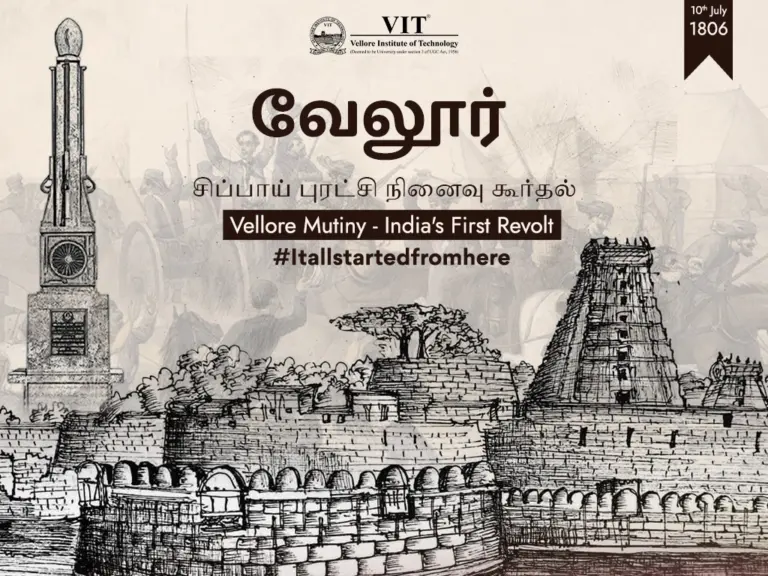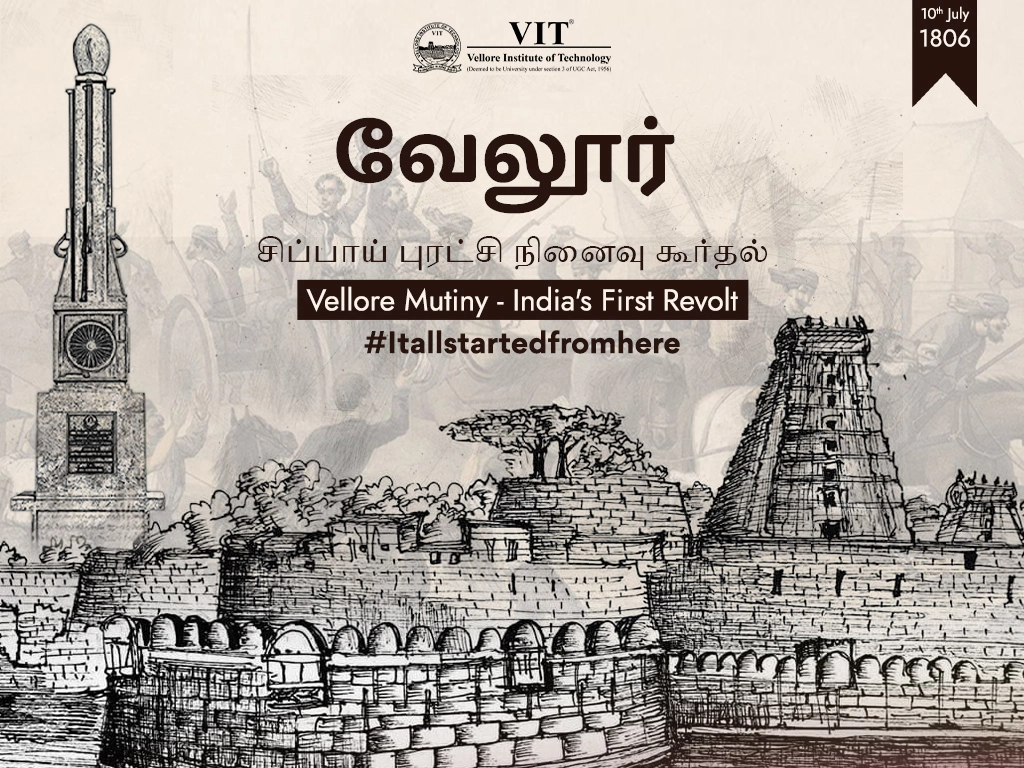Vellore Sepoy Mutiny: A New beginning in the History of India's Freedom Struggle!
Vellore Sepoy Mutiny: A New beginning in the History of India's Freedom Struggle!
- By Aathithan (Tamil) & Manikandan (Translation in English)
The Vellore Sepoy Mutiny completes 219 years since it took place in 1806. The Vellore Sepoy Mutiny in Tamil Nadu created a new era in the history of India’s freedom struggle, which was enslaved under British rule. At the end of the 18th century, as the English East India Company was expanding its dominance in India, Tipu Sultan was defeated and killed in the War in 1799. His family and supporters were imprisoned in the Vellore Fort. Vellore Fort was one of the important military centers of the British. Indian sepoys were waiting to rise up due to dissatisfaction caused by British oppression. The military law & regulations introduced by the British were a major cause of the Indian Sepoy Mutiny.
The background for the Vellore Sepoy Mutiny was laid in 1805 when strict dress codes were imposed on Indian sepoys under the orders of British Commander-in-Chief Sir John Cradock. The prohibition of religious practices, the ban on Muslim sepoys growing beard, and the order to wear a new turban made of cowhide hurt the religious sentiments of both Hindu and Muslim sepoys. The disrespectful treatment of Indian sepoys and racial discrimination by British officers had provoked the anger of the sepoys. The imprisonment of Tipu Sultan’s sons, who were killed by the British, in the Vellore Fort, acted as a catalyst for the sepoy mutiny.
On July 10, 1806, at 2 AM, Indian sepoys from the 1st and 23rd regiments, led by Subedars Sheikh Kathom, Sheikh kaasim and Sheikh Hussain, launched the rebellion in Vellore Fort. The British forces were taken by surprise and destabilized by the unexpected early morning attack. Officers, including Colonel St. John Fancourt, were killed in the aggressive attack by the Indian sepoys. The British flag was removed, and Tipu Sultan’s tiger flag was hoisted on the fort. Tipu Sultan’s son, Pathar Hyder, was declared and announced the new ruler.
Upon learning about the loss of Vellore Fort, British forces led by Colonel Robert Gillespie arrived from Arcot and after a fierce fight, they recaptured the fort from the Indian sepoys within a few hours. 350 Indian sepoys involved in the rebellion were killed. 100’s were arrested and sentenced to death. The bodies of the British killed in the sepoy mutiny were buried opposite the fort, and a tomb was erected in remembrance of them.
A memorial pillar was erected in the Makkan area of Vellore in memory of the brave soldiers who lost their lives in the Sepoy Mutiny. In 2006, a commemorative postage stamp for the Sepoy Mutiny was also released to mark its anniversary.
Although the Vellore Sepoy Mutiny lasted only one day, it marked the beginning of a new chapter in India’s freedom struggle. It served as a precursor to the Great Sepoy Mutiny of 1857. At the end of the Vellore Sepoy Mutiny, the British government withdrew the new dress codes, and officers including Commander-in-Chief Sir John Cradock were dismissed from their posts.
இந்தியாவின் சுதந்திர போராட்டத்துக்கு வித்திட்ட வேலூர் சிப்பாய் புரட்சி 219-ம் ஆண்டு நினைவு தினம்
வீர வணக்கம் செலுத்தி நினைவு கூர்கிறது விஐடி பல்கலைக்கழகம்
இந்திய சுதந்திர போராட்டத்துக்கு வித்திட்ட வேலூர் சிப்பாய் புரட்சி (1806) அரங்கேறி 219-ம் ஆண்டு நினைவு தினம் இன்று (ஜூலை 10) அனுசரிக்கப்படுகிறது. ஆங்கிலேயர்களின் தாக்குதலில் வீர மரணடைந்த இந்திய வீரர்களின் உயிர் தியாகத்தைப் போற்றும் வகையில் வீர வணக்கம் செலுத்தி நினைவு கூர்கிறது வேலூர் விஐடி பல்கலைக்கழகம்.
18-ம் நூற்றாண்டின் இறுதியில் ஆங்கிலேய கிழக்கிந்திய கம்பெனி இந்தியாவில் தனது ஆதிக்கத்தை விரிவுப்படுத்திக் கொண்டிருந்தது. 1799-ம் ஆண்டில் மைசூர் போரில் திப்பு சுல்தான் தோற்கடிக்கப்பட்டு கொல்லப்பட்டார். அவரது குடும்பத்தினர், ஆதரவாளர்கள் வேலூர் கோட்டையில் சிறை வைக்கப்பட்டனர்.
ஆங்கிலேய படையில் இந்து, முஸ்லிம்கள் என இந்தியர்கள் ஆயிரக்கணக்கானோர் சேர்க்கப்பட்டிருந்தனர். இந்திய வீரர்களுக்கு மத அடையாளங்களுக்கு தடை விதித்தது. புதிய ஆடை கட்டுப்பாடுகளையும் கொண்டு வந்தது. மேலும் பசு, பன்றியின் கொழுப்பு தடவிய துப்பாக்கி தோட்டாக்களை பயன்படுத்துவதை இந்திய வீரர்கள் எதிர்க்க தொடங்கினர்.
ஆங்கிலேயரின் அடக்குமுறையால் வெகுண்டெழுந்த இந்திய வீரர்கள் 1806 ஜூலை 10-ம் தேதி அதிகாலை 2 மணி அளவில் வேலூர் கோட்டையில் தங்கியிருந்த ஆங்கிலேய அதிகாரிகளை சுட்டு கொன்றனர்.
வேலூர் கோட்டையை முழுவதுமாக கட்டுப்பாட்டுக்குள் கொண்டு வந்து ஆங்கிலேயர்களின் ஆயுதக் கிடங்கை கைப்பற்றியதுடன், கோட்டையில் சிறை வைக்கப்பட்டிருந்த திப்பு சுல்தானின் குடும்பத்தினரை மீட்டனர். ஆங்கிலேய கொடியை இறக்கி திப்பு சுல்தானின் புலிக்கொடியை கோட்டையில் ஏற்றினர்.
இதுகுறித்து தகவலறிந்து ஆற்காட்டில் இருந்து வந்த கர்னல் கில்லஸ்பி தலைமையிலான ஆங்கிலேய படை வேலூர் கோட்டையில் இருந்த இந்திய வீரர்களை சுட்டு தள்ளினர். சுமார் 350 இந்திய வீரர்கள் வீர மரமணடைந்தனர்.
சிப்பாய் புரட்சியில் வீரமரணம் அடைந்த வீரர்களின் நினைவாக வேலூர் கோட்டை அருகே மக்கான் சந்திப்பில் சிப்பாய் புரட்சி நினைவு தூண் அமைக்கப்பட்டுள்ளது. வீரமரணம் அடைந்த வீரர்களுக்கு ஆண்டுதோறும் தமிழக அரசு சார்பில் ஜூலை 10-ம் தேதி நினைவு தினம் அனுசரிக்கப்பட்டு அஞ்சலி செலுத்தப்படுகிறது.
அதன் ஒரு பகுதியாக, இந்திய சுதந்திர போராட்டத்துக்கு வித்திடும் வகையில் வீர மரமணடைந்த வீரர்களின் தியாகத்தை வேலூர் விஐடி பல்கலைக்கழகம் வீர வணக்கத்துடன் நினைவு கூர்கிறது.







